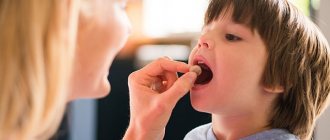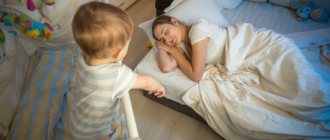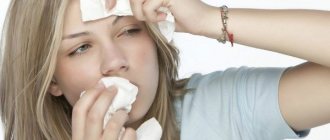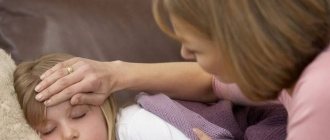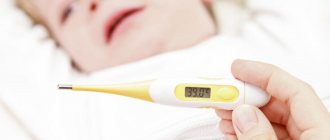Types of children's cough
A frequent dry cough may indicate the development of an infectious disease in a child. Therefore, you should not delay and take action as soon as possible. Only a doctor can determine what type of cough a child is suffering from. Therefore, under no circumstances should you try to make a diagnosis yourself when a child is coughing.
Physiological cough in a child
This type is a natural cough and does not require treatment. Its function is to cleanse the respiratory tract of mucus and foreign objects. When you cough, air leaves the lungs under pressure, thereby taking mucus and phlegm with it.
It is worth noting that a healthy child can cough up to 15 times a day. The main signs of a physiological cough are short duration, periodicity, and absence of temperature.
Important! Do not confuse a physiological cough with a pathological one, since it does not require treatment, and the use of expectorants can aggravate the situation.
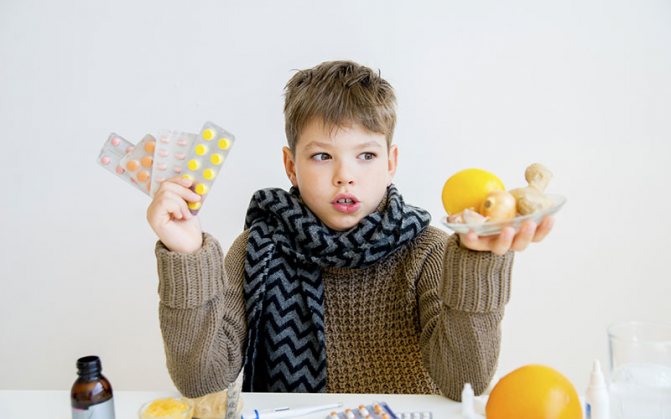
Pathological cough is a sign of ARVI in children
This type of cough is pathological and therefore occurs due to illness. Despite the fact that a pathological cough may indicate cardiovascular disease, most often it is the main symptom of colds.
Common diseases in children:
Scarlet fever Whooping cough Laryngitis Meningococcal infection Otitis Dry cough
The peculiarity of a pathological cough is its duration. Unlike physiological, it affects the child’s activity and can change as it progresses.
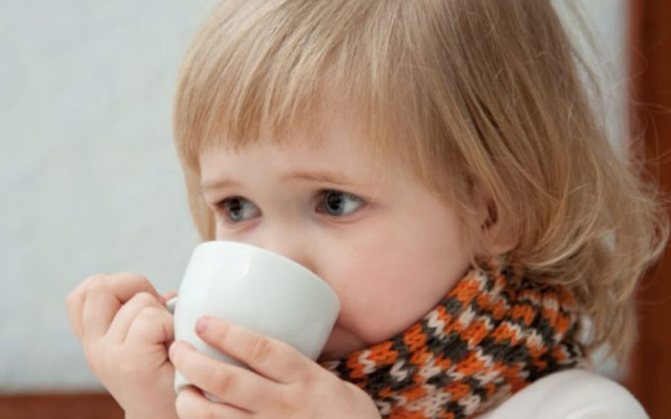
Acute cough and fever
Acute cough is one of the most common companions of ARVI. It develops over several days in addition to a runny nose, fever and fever. Acute cough is characterized by changes from dry to wet during the period of progression.
kindergarten child is often sick
If a child cries every morning and begs not to take him to kindergarten, it is important to think about why he reacts this way? Communication with peers and exploration of new space are natural needs for a three-year-old child. Of course, at first the new environment and daily routine are unusual for the child. But these changes are stressful not only for children, but also for parents. Mom experiences mixed feelings: anxiety, fear, guilt. An endless stream of questions haunts me: Will the teacher pay due attention? Will his children hurt him? And most importantly, how will he cope without me? After all, for so long (starting from the moment of pregnancy) the mother and her child were one. Mom is used to controlling the baby, because sometimes it is vital, especially during infancy and early childhood. And now a new time has come, the child is growing up and needs not only his mother. He is interested in a world that he does not yet know, but in which he will live his whole life.
Always together.
Often mothers taking a crying child to kindergarten think how bad he is there. That the baby wants to be with his mother always and everywhere. But in reality the opposite happens. By the age of two or three, the child needs separation from his mother, independence, and communication with other children. Whereas the mother feels a strong need for the child. She doesn’t want to let him go, because she might feel unwanted. On an unconscious level, the child receives the message that his mother will suffer if he happily goes to kindergarten. Being very young, he is already experiencing a strong internal conflict. On the one hand, there are his needs for development and exploration of the world, the desire to communicate with other children. On the other hand, the responsibility for the calm and well-being of the mother has fallen on the fragile children’s shoulders.
Of course, it’s hard to realize that a mother’s severe anxiety, her hypercontrol, which is disguised as care, can significantly harm the child and complicate adaptation to new conditions. Very often you can hear the phrase “I don’t want to go to kindergarten, there are only diseases there.” But a child is not always sick because he got his feet wet while walking. Sometimes such a reaction of the body occurs in response to the mother’s condition.
What to do?
It is important to understand that your child has already grown up and he needs to develop and begin to build relationships with the world around him. He really needs your support and approval during this difficult period for him. And perhaps your feelings do not allow the child to painlessly separate from you. Ask yourself the question: “How do I feel when I take my child to kindergarten?” After analyzing your feelings, perhaps you will understand why your child throws tantrums and does not want to go to kindergarten. Of course, it’s not easy, but it’s worth a try, because the happiness and mental health of your baby directly depend on you.
Author: psychologist Timofeeva Victoria Valerievna
Source: https://www.granisoznaniya.ru/stati/pochemu-rebenok-ne-khochet-khodit-v-detskijj-sad/
Treatment of cough in children
Since coughing is a natural protective process of the body, treatment should primarily be aimed at alleviating it. If a child is often sick and suffers from a dry cough, physical therapy can improve his condition.
Inhalation using hot steam is one of the methods of combating dry cough. With its help, you can warm up the upper respiratory tract, thereby reducing the severity of cough and diluting the viscosity of sputum.
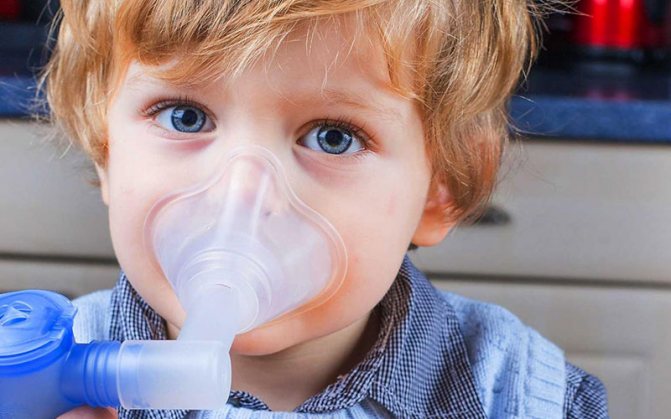
UHF therapy is based on the effect of high-frequency magnetic waves on the body. The main task of the procedure is to destroy pathogenic bacteria, as well as warm the upper respiratory tract.
It is important to remember that treatment of dry cough in children under 2 years of age with mucolytic agents is prohibited. Since at this age the medicine has many side effects.
Find out how ARVI is treated in children. Why does a child often get sick and how to properly treat a cough from the main expert Dr. Komarovsky.
Tags: viruses, childhood illnesses, diseases, cough, treatment
My child is often sick at school, what should I do? What do schoolchildren get sick with most often?
Children at school get sick mainly from those ailments that are easily transmitted from person to person. These are colds, flu, rubella, chickenpox, skin lesions of various natures and even lice. There are plenty of threats. But, oddly enough, younger schoolchildren are beginning to develop diseases that cannot be contracted. For example, scoliosis, gastritis, neurological disorders. It would seem, where is the connection?
Contagious diseases are understandable. But what about the non-infectious ones? Parents usually think that their children get sick because of school. Allegedly, the workload in educational institutions is too heavy, there are no conditions for normal development, and so on. In fact, non-communicable diseases do not appear out of thin air.
Most often, they simply worsen when the child goes to first grade, or returns to school after a long summer vacation. There is additional workload, stress, and you have to put in more physical effort. As you know, “where it’s thin, it breaks.” This is where all the problems pop up that were previously either not noticed by parents or were in their infancy.
Some diseases are purely neurotic in nature. First of all, this applies to headaches and neuroses themselves. But this can also include, for example, a runny nose. Now we see that there are a huge number of diseases to which schoolchildren are exposed. Let's move on to the reasons for their occurrence and methods of struggle.
Causes
An increase in temperature is a protective reaction of the body aimed at destroying a pathogen that has penetrated a person, including a child. This is considered even better if the illness is accompanied by a mild fever. A slight increase in temperature stimulates the immune system; febrile numbers can be detrimental to foreign protein.
The main cause of respiratory symptoms, which are accompanied by a rise in temperature, is, of course, bacterial and viral infections. ARVI, influenza, tonsillitis, scarlet fever usually occur with a serious excess of normal values. Moreover, different diseases are characterized by a specific type of fever. Symptoms similar to ARVI without temperature fluctuations can be caused by:
- Allergies (rhinitis, lacrimation, cough, sneezing, low-grade fever, redness of the pharyngeal mucosa), including bronchial asthma.
- Helminthiasis (cough, indigestion, weakness).
- Heart pathology (accompanied by cough, weakness).
- Oncological diseases (cough, low-grade fever, weakness, weight loss) and other reasons.
- Fungal tonsillomycosis (weakness, moodiness, loss of appetite, specific plaque on the tonsils, tongue, cheeks).
- Growth of teeth in the first year of life (accompanied by rhinitis, sometimes stomatitis, redness of the pharyngeal mucosa, indigestion, diarrhea, anxiety, loss of appetite and sleep disturbances).
If a child is sick for a long time, coughs or sneezes, his nose is constantly stuffy and his eyes are watery, it is necessary to conduct a thorough examination for the presence of additional causes of illness. Allergies rarely cause high fever and, at the initial manifestation of symptoms, are often perceived as influenza or ARVI, unless appropriate blood tests have been carried out.
Frequent respiratory diseases that occur without an increase in body temperature indicate a decrease in the overall reactivity of the body. In this case, answering the question whether it is good or bad that the baby suffers an infection without fever is quite simple. This is definitely sad - the infectious agent quietly multiplies and poisons the small organism, and the baby’s immune system can do nothing or almost nothing to counteract it in response.
A child may get sick without fever while receiving medication. Often parents rush to give their child NSAIDs and even antibiotics. For a viral infection, antibacterial therapy is ineffective and can cause fungal and secondary bacterial infections.
Products advertised as effective against flu and cold symptoms should not be given to children. Or give it to him as a last resort. Because they specifically fight the symptoms, that is, they neutralize the clinic without affecting the cause of the person’s painful condition.
Fungal tonsillomycosis (candidiasis of the tonsils) often occurs without a clear clinical picture, including fever. It is not uncommon in children of the first year of life. And the absence of temperature in this case should not cause concern.
The growth of teeth in infants often occurs with catarrhal symptoms and rhinitis. A bacterial infection may also occur, because at this moment the baby’s body is weakened. But such phenomena are usually accompanied by drooling, sometimes low-grade fever. Severe fever rarely develops (usually due to hypothermia and the addition of a bacterial or viral infection).
If a child is sick without fever, but gets sick extremely rarely and recovers very quickly, this may be a sign of the body’s high resistance to the pathogen. The immune system was able to suppress the growth of microorganisms in a short time, and, as a result, the inflammatory reaction disappeared.
What to give a child for a dry cough medicine
For non-productive cough symptoms, medications are prescribed according to the type of cough and its causes. In case of severe attacks, antitussive medications help. The main thing is to achieve sputum discharge. For wet cough, mucolytics and expectorants are relevant. Treatment for a 6-year-old child is simpler than for younger children. School-age children can be treated for colds in almost the same ways as adults.
What medications are relevant in the treatment of non-productive cough symptoms.
- Antitussive medications. They relieve severe attacks (Bronchicum, Sedotussin).
- Mucolytics reduce the density of sputum. These include Lazolvan, Ambrobene.
- Expectorant medications accelerate the evacuation of mucus (Pertussin, Mucaltin).
Every parent should familiarize themselves with the effects of the cough medicine they plan to buy. It is also important to know what substances are included in the medications.
- "Bronchicum S" is an antitussive herbal medicine. The medication has an antibacterial effect and relieves pain during attacks. Produced in the form of syrups and lollipops. Bronchicum S lozenges can be given to children from 6 years of age, 1 piece 3 times a day.
- "Sedotussin." The medicine has an anesthetic effect. The drug is effective for relieving cough attacks. Children from 6 to 10 years old can drink half a dessert spoon 3 times a day. If you have a wet cough and bronchial asthma, this medication is prohibited for use.
- "Lazolvan." Helps in cases of cough symptoms with thick sputum that is difficult to separate. The drug is available in syrup form and is approved for use by children over 6 years of age. Drink a teaspoon 3 times a day.
Good to know - What can children over 10 years old do for a cough?
There are other drugs that help eliminate a cough attack. The treating doctor will prescribe an individual dosage of medications to achieve maximum results. You will need to follow the instructions strictly, otherwise the opposite effect may occur.
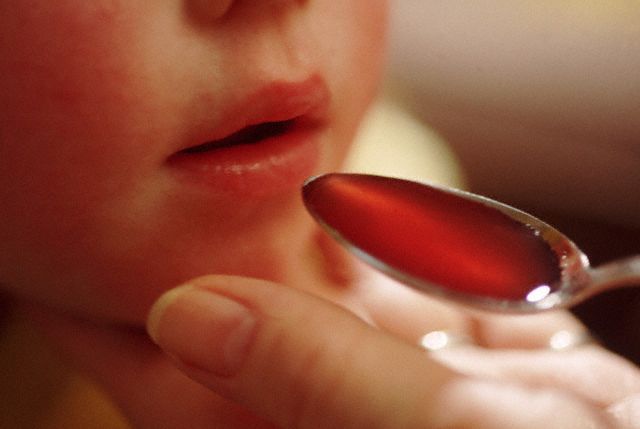
Treatment

Unless there is a severe fever, children should not be given NSAIDs. You should definitely try to find out the cause of the baby’s illness and why there is no temperature. In any case, it is necessary to show the child to the pediatrician and follow his instructions.
If the baby’s condition is caused by allergies, the doctor will recommend antihistamines (Erius, Fenistil), prebiotics, and enterosorbents. If necessary, enzymes. To treat helminthiases, special anthelmintic drugs (Pyrantel) are used. If the disease is caused by a virus or bacteria, the child can be helped by:
- Nasal rinsing.
- Gargling.
- Drink plenty of fluids.
- Vitamins.
- Warming procedures (in the absence of fever).
- Regular wet cleaning of his room and ventilation.
When rhinitis develops, rinsing the nasal passages with pharmaceutical and homemade saline solutions and saline has a good effect.
You can drip your baby’s nose with regular saline solution, but you don’t need to buy bottles of 100 ml or more, but plastic ampoules of 10 ml. This is explained by the fact that in an unopened bottle, even if stored in the refrigerator for only 2-3 days, bacteria (for example, E. coli) will begin to multiply. Putting a drug contaminated with bacteria into your baby's nose is not a good idea. A small ampoule will last for a day. The rest of the solution will remain sterile.
Additional Methods

From the moment when a child can be given fruit drinks and natural compotes and juices, this becomes one of the main means in the treatment of diseases caused by bacterial and viral infections. Drinking plenty of warm, vitamin-rich foods allows the baby’s body to quickly overcome the disease. The best juices, fruit drinks or decoctions in this situation:
- Cranberry.
- Crimson.
- Strawberry.
- Rosehip.
For a sore throat and cough, you can use balms and rubs (Doctor Mom, Golden Star, camphor oil, etc.). If the child is not allergic, aromatherapy is a good preventative against infectious and bacterial diseases. For example, it is recommended to drop the complex drug “Breathe” onto a child’s pillow or place an aroma lamp in the room. Even if the baby happens to get sick, at the height of the infectious process this remedy is an effective auxiliary measure in the treatment of the disease. You can also use mono oils (lavender, eucalyptus, coniferous trees).
You should not get carried away with aromatic oils for treating babies and newborns, so as not to provoke the development of allergies. For small children 3–6 years old, it is better to make pillows with herbs (lavender, for example) and place them away from the child’s head (on a heating radiator).
Methods for treating colds without fever in a child
Any cold must be treated promptly so that it does not become complicated and develop into another disease. The following treatment methods are used:
- When a child has a runny nose, drops, sprays, and traditional methods of treatment are used.
- If the cough is severe, the child is given medicine or tablets. In this situation, it is necessary to consider whether the cough is dry or wet.
- The child must drink constantly. Give your child a warm drink - milk, tea with lemon, compote.
- Antiviral drugs relieve symptoms.
- Constantly ventilate the room.
- In the room where the child is, the air should not be dry. To do this, constantly do wet cleaning.
- The child must have his own dishes.
If you treat a cold in time, after 3 days the child will feel better and will be on the mend.
What determines the rise in temperature?
- From the causative agent of colds. Fever often accompanies the flu virus. The child’s immune system may not respond to other viruses at all.
- From the state of the immune system. The child’s temperature rises as a result of a reaction to pathogenic microflora. The body begins to actively produce antibodies, so the body temperature rises sharply. Some children have a weakened immune system; it cannot fight viruses, so the body temperature does not rise. This is a dangerous symptom because the immune system does not respond to the virus.
- From the effects of medication . Today there are a large number of remedies for treating colds in children. Medicines can not only fight the virus, they affect the symptoms of a cold, some lead to an increase or decrease in body temperature. Many mothers do not notice that the medication contains Paracetamol and Ascorbic acid, which completely reduce body temperature.
